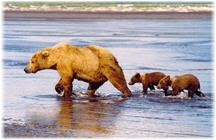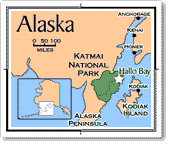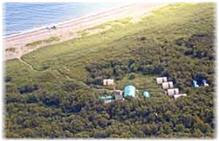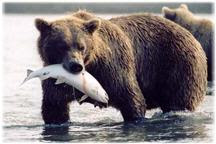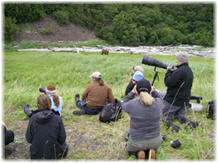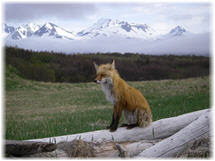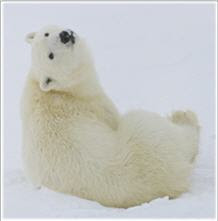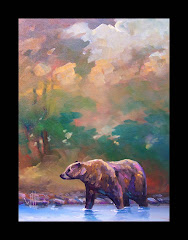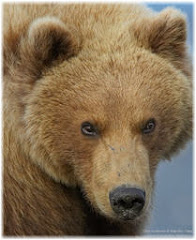Enjoy the video coverage of KTVA on Hallo Bay Bear Camp habitat preservation.
Wednesday, July 23, 2014
Monday, July 21, 2014
Sunday, July 20, 2014
Wolves
A light-reflecting layer on a wolf’s eye called the tapetum
lucidum (Latin for “bright tapestry”) causes a wolf’s
eyes to glow in the dark and may also facilitate night vision.
While a wolf’s color perception and visual acuity maybe be
inferior to a human’s, a wolf’s eyes are extremely sensitive to
movement.
Saturday, July 19, 2014
Friday, July 18, 2014
Chum Salmon
Chum salmon, also known as dog salmon, are the most widely
distributed of all the Pacific salmon and generally occur
throughout Alaska. Like most other Pacific salmon species,
chum salmon spend most of their life feeding in saltwater,
then return to freshwater when mature to spawn once in the
fall then die. Most chum salmon populations do not travel far
upstream to spawn; however, some travel up to 2,000 miles
upstream to the headwaters of the Yukon River. Although
generally regarded as one of the less desirable species of
salmon, in Arctic, Northwestern, and Interior Alaska, chum
salmon are highly prized as a traditional source of dried
winter food. Since the 1980s, commercial chum salmon harvests
in Alaska have more than doubled as a result of the Alaska
hatchery program and increased foreign sales.
Thursday, July 17, 2014
Ravens in Alaska
Ravens are excellent fliers, engaging in aerial
acrobatics and sometimes soaring to great heights. Flight
is often an alternation of wing flapping and gliding and
is deceptively fast, as ravens move quickly with seemingly
slow wing beats. In courtship flights ravens fly with
wingtips touching, and repeatedly dive and tumble
together.
There is no mistaking the raucous call of the raven; the deep, resonant “kaw” or “prruk prruk prruk” is its trademark. However, the raven can produce an amazing assortment of sounds: mews, whistles, high-pitched cries, “glooks,” and dripping water sounds. One study in Alaska showed ravens have more than 30 distinct vocalizations.
There is no mistaking the raucous call of the raven; the deep, resonant “kaw” or “prruk prruk prruk” is its trademark. However, the raven can produce an amazing assortment of sounds: mews, whistles, high-pitched cries, “glooks,” and dripping water sounds. One study in Alaska showed ravens have more than 30 distinct vocalizations.
Wednesday, July 16, 2014
Tuesday, July 15, 2014
Monday, July 14, 2014
Saturday, July 12, 2014
Wolf facts
- In the Harry Potter universe, werewolf Remus Lupin’s name is directly related to the Latin word for wolf (lupus) and suggests an association with one of the founders of Rome, Remus, who was suckled by a wolf. The dual nature of Lupin’s werewolf nature suggests that in the Potter realm, there are two sides to everything.
- The last wolf in Yellowstone Park was killed in 1926. In 1995, wolves were reintroduced and, after just ten years, approximately 136 wolves now roam the Park in about 13 wolf packs.
- Currently, there are about 50,000 wolves in Canada; 6,500 in Alaska; and 3,500 in the Lower 48 States. In Europe, Italy has fewer than 300; Spain around 2,000; and Norway and Sweden combined have fewer than 80. There are about 700 wolves in Poland and 70,000 in Russia.
Friday, July 11, 2014
Ermine in Alaska
Ermine are adapted to a wide variety of habitats. It
prefers wooded areas with thick understory near
watercourses, and often occupies early-successional or
forest-edge habitats, wet meadows, marshes, ditches,
riparian woodlands, or river banks with high densities
of small mammals and adequate subnivean foraging
space. Coastal ermine may exhibit a preference for low
elevation riparian and marine shoreline and estuarine
habitats. They are well-adapted to snowy environments
and range into alpine areas. They have been documented
year-round living at 2,000–3,000 ft in the Sierra
Nevada, California and also successfully inhabit
tundra habitats throughout northern Canada and Alaska.
Thursday, July 10, 2014
Wednesday, July 9, 2014
Monday, July 7, 2014
Bird Facts
- Birds play a central role in many creation myths. Birds are also often associated with the journey of the soul after death or as mediators between the dead and living. They can also appear as oracles or tricksters.
- The game Angry Birds has sold more than 7 million copies on Apple’s iPhone. The game was made by a team of just four people. It was such a low priority for the company that it took over 8 months to finish.
- Wind farms kill approximately a half-million birds per year in the United States, according to a 2008 Fish and Wildlife study. Nearly 10,000 birds, almost all of which are protected by the migratory bird acts, are killed every year at the wind farm in Altamont Pass, CA, alone.
- Approximately 200 people have died since 1988 because of airborne collision between airplanes and birds. Bird strikes cause $300 million of damage each year to aircraft. The first recorded bird strike was in 1905, when Orville Wright’s plane hit a bird and killed it.
Sunday, July 6, 2014
Leave No Trace Camping and Hiking
1. Trash your Trash
Put litter—even crumbs, peels and cores— in garbage bags and carry it home or throw it in trash receptacles. Extra food, even apple cores and banana peels can do great damage to wildlife. Did you know it takes up to two years for orange or banana peels to decompose in nature; more than 10 years for plastic bags and more than 80 years for aluminum cans to decompose?
2. Dog Dogma
Use a plastic bag to pack out your dog’s poop to a garbage can. Dog waste can be harmful to the natural environment and can cause the spread of invasive species.
3. Take Only Pictures. Leave Only Footprints
According to U.S. state and national park services, Americans logged 1.6 billion visits to national and state park lands last year. If we all took a memento from nature during those visits, the landscape would change. Fill the memory card on your camera rather than your pockets and leave nature as you found it for others to enjoy.
4. Keep Wildlife Wild
Human food is unhealthy for all wildlife and feeding them can have unfortunate consequences such as drawing them to people and roads and making them sick.
5. Refuse the Makeover
No need for a major remodel of nature. Bring your own lightweight camp or picnic furniture and conveniences such as camp gas stoves, sleeping pads, chairs and lanterns. When you leave, it should look as though you were never there.
Put litter—even crumbs, peels and cores— in garbage bags and carry it home or throw it in trash receptacles. Extra food, even apple cores and banana peels can do great damage to wildlife. Did you know it takes up to two years for orange or banana peels to decompose in nature; more than 10 years for plastic bags and more than 80 years for aluminum cans to decompose?
2. Dog Dogma
Use a plastic bag to pack out your dog’s poop to a garbage can. Dog waste can be harmful to the natural environment and can cause the spread of invasive species.
3. Take Only Pictures. Leave Only Footprints
According to U.S. state and national park services, Americans logged 1.6 billion visits to national and state park lands last year. If we all took a memento from nature during those visits, the landscape would change. Fill the memory card on your camera rather than your pockets and leave nature as you found it for others to enjoy.
4. Keep Wildlife Wild
Human food is unhealthy for all wildlife and feeding them can have unfortunate consequences such as drawing them to people and roads and making them sick.
5. Refuse the Makeover
No need for a major remodel of nature. Bring your own lightweight camp or picnic furniture and conveniences such as camp gas stoves, sleeping pads, chairs and lanterns. When you leave, it should look as though you were never there.
Friday, July 4, 2014
Thursday, July 3, 2014
Alaska Brown Bears
Brown and grizzly bears are classified as the same species
even though there are notable differences between them. Kodiak
bears (brown bears from the Kodiak Archipelago) are classified
as a distinct subspecies (U. a. middendorffi) from
those on the mainland (U. a. horribilis) because they
have been isolated from other bears since the last ice age
about 12,000 years ago. “Brown bears” typically live along the
southern coast of the state where they have access to
seasonally abundant spawning salmon. The coastal areas also
provide a rich array of vegetation they can use as food as
well as a milder climate. This allows them to grow larger and
live in higher densities than their “grizzly” cousins in the
northern and interior parts of the state.
Wednesday, July 2, 2014
Tuesday, July 1, 2014
Monday, June 30, 2014
Black Capped Chickadee
- Size
4.7–5.9 inches, .3–.5 oz - Range/Distribution
Deciduous and mixed forests across the north-central US and up into Interior Alaska. - Diet
Insects and seed. - Predators
Very few but known nest predators include red squirrel and black bear. - Reproduction
Single clutch per year with 1 to 13 eggs
Sunday, June 29, 2014
Fox
- Size
Weight: 6–15 lbs
Body Length: 22–32 inches
Tail Length: 14–16 inches - Lifespan
3 years - Range/Distribution
It is found throughout Alaska, except for some of the islands of Southeast Alaska and the western Aleutians and is rare in Prince William Sound. - Diet
Omnivorous; eats muskrats, squirrels, hares, birds, eggs, insects, vegetation, carrion, voles. - Predators
Wolves, coyotes, eagles, bears, mountain lions, lynx, humans. - Reproduction
Breed once per year in February and March. Females give birth to litters ranging from 1–10 pups after a 51–54 day gestation period.
Saturday, June 28, 2014
Friday, June 27, 2014
Wednesday, June 25, 2014
Wolf Info
- Between 6,000 and 7,000 wolf skins are still traded across the world each year. The skins are supplied mainly by Russia, Mongolia, and China and are used mainly for coats.
- In India, simple wolf traps are still used. These traps consist of a simple pit, disguised with branches or leaves. The wolves fall in and people then stone them to death.
- Wolves were the first animals to be placed on the U.S. Endangered Species Act list in 1973.
- John Milton’s famous poem “Lycidas” derives its title from the Greek for “wolf cub,” lykideus.
Monday, June 23, 2014
Ermine
Ermine are carnivores that consume mainly small mammals,
especially voles (Microtus spp., Clethrionomys spp.)
and mice (Peromyscus spp). Shrews and rabbits may
also be taken and occasionally other small vertebrates and
insects. Ermine foraging strategies are particularly
well-adapted to northern environments where prolonged snow
cover gives small predators, able to access under-snow
tunnels, a competitive advantage, and where voles are the
most abundant prey species. On Kodiak Island, Alaska,
resident tundra voles (Microtus oeconomus)
provide the bulk of ermine food supply, although these
ermines have also been observed taking fish from a river.
Sunday, June 22, 2014
Eagles
Accounts of eagles carrying off dogs and cats are
unsubstantiated and highly unlikely. An eagle can lift
about three or four pounds, more if it swoops down. Bald
eagles are strong aggressive birds but like everything
that flies, they are governed by aerodynamics. The wings
of an eagle need to support the 8 to 12-pound bird as well
as whatever the bird is carrying and best estimates put
the lifting power of an eagle at about 4 pounds. That
varies, however, depending on the circumstances. Lift is
dependent on air speed as well as wing size. The faster a
bird (or airplane) is flying, the greater the lift
potential. An eagle that lands on the beach to grab a fish
and take off is limited to a smaller load than an eagle
that swoops down at 20 or 30 miles an hour and snatches up
a fish. Momentum and speed give the bird the ability to
carry more weight.
Saturday, June 21, 2014
Friday, June 20, 2014
Beaver
If the habitat does not have the necessary water level,
beavers construct dams. Each dam is a little different. A
beaver may work alone or with family members to build a
dam, using piled logs and trees secured with mud, masses
of plants, rocks, and sticks. Although the average tree
used for construction of a dam is 4 to 12 inches (10–30
cm) across the stump, use of trees up to 150 feet (45 m)
tall and 5 feet (115 cm) across have been recorded. As the
tree snaps, the beaver runs! Very large trees are not
moved but the bark is stripped off and eaten. Smaller
trees are cut into moveable pieces, dragged into the water
for repairing dams and lodges. This work is done mainly in
spring and autumn.
Thursday, June 19, 2014
Ptarmigan
Families of willow ptarmigan join to form flocks in
September. The ptarmigan then begin to move around more
than in the nesting season. Females and males tend to
separate in late September and October; the females,
usually in small groups, seek food and shelter at lower
elevations. In most parts of Alaska these movements to and
from summer ranges encompass only a few miles. Hens that nest or were
reared on the north slope of the Brooks Range move up to
100 miles southward in late fall, wintering on the south
side of the Brooks Range in the low hills and wooded
valleys north of the Yukon River in the east, or in the
valleys of the Noatak and Kobuk Rivers to the west. Males
of these same populations also largely abandon summer
ranges, but do not go as far south as the females. The
south-tending migrations take place in October and
November. The northward movements begin in February, reach
a peak in April, and are finished by mid-May.
Monday, June 16, 2014
Wonderful Wolves
Wolves are skilled and ferocious hunters, but when it it comes to
relationships, they're real softies. When a playmate or partner
leaves the pack, the wolves that are left behind will howl and
howl and howl.
In a new study, researchers report that wolves will give their leaders and their closest allies a longer and stronger serenade if they leave. Those howls could be sonic breadcrumbs, meant to help a lone wolf find its way back to the pack.
In a new study, researchers report that wolves will give their leaders and their closest allies a longer and stronger serenade if they leave. Those howls could be sonic breadcrumbs, meant to help a lone wolf find its way back to the pack.
Sunday, June 15, 2014
Subscribe to:
Comments (Atom)

.jpg)
.jpg)
.jpg)
.jpg)
.jpg)
.jpg)
+(Small).jpg)
+(Small).jpg)
.jpg)
.jpg)
.jpeg)
.jpeg)
.jpeg)

.JPG)
.jpg)
.jpg)
.jpg)
.jpg)
.jpg)
.jpg)
+(Small).jpg)
+(Small).jpg)
.JPG)

.jpg)
.jpg)
.jpg)
+(Small).jpg)
.jpg)
+(Small).jpg)
+(Small).jpg)
+(Small).jpg)
+(Small).jpg)
.jpg)
.jpg)
.JPG)
+(Small).jpg)
+(Small).jpg)
+(Small).jpg)
.jpg)
.jpg)
.jpg)
.jpg)
.jpg)
.jpg)
.jpg)

.jpg)
.jpg)
.jpg)
.jpg)




 Alaska Time
Alaska Time